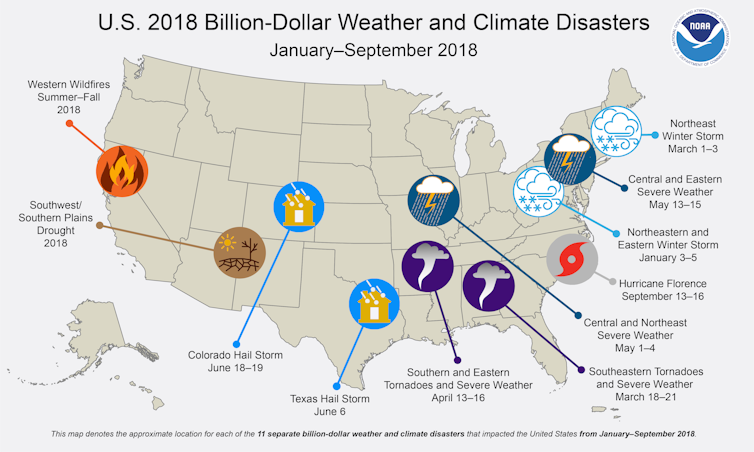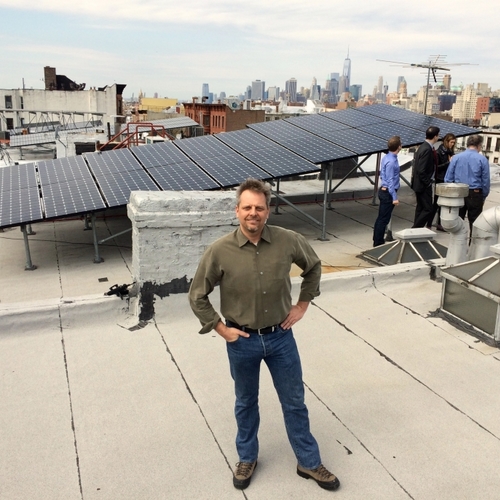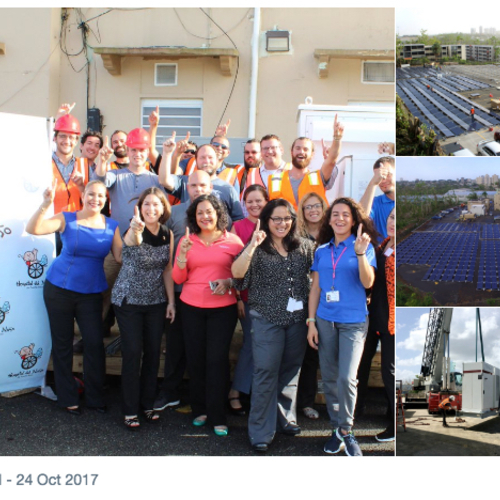
Polar vortexes. Hurricanes. Wildfires.
With climate change making extreme weather events more frequent and intense, it is getting harder to keep the lights on and HVAC systems running.
As a power system researcher, I believe utilities need to get better at withstanding disasters and the disruption they cause. Investing more heavily is key, especially in infrastructure upgrades, renewable energy and microgrids — small and self-sufficient sources of power that help consumers either stay off the grid by choice or simply stay connected during outages.
Different kinds of weather can obstruct access to electricity.
In extreme cold snaps, like the one that froze a large swathe of the U.S. in early 2019, crucial equipment like circuit breakers, switches, grid sensors, and other electromechanical support equipment can operate slower or faster than normal, sometimes leading to plants shutting themselves down — potentially causing power outages.
Around 300,000 customers lost power in Michigan and New Jersey due to winter storms in 2018.
In 2019, 1,500 customers temporarily lost power when power lines snapped in Kenosha County, Wisconsin, and thousands more had to shiver through the coldest night in decades in Minnesota’s Twin Cities region and parts of Illinois.
During hurricanes, high-speed winds can knock down transmission and overhead distribution power lines, as happened in 2018 with Hurricane Michael in Florida and Hurricane Maria in Puerto Rico in 2017.
Unfortunately, there are no easy fixes.
While burying power lines underground protects them from gusts, it then makes them vulnerable to floods and earthquakes. In areas that regularly experience high temperatures, electricity use can spike due to heavy demand for air conditioning during heat waves. And when demand exceeds supply, it can cause outages.
Within the first nine months of 2018, 11 disastrous weather events hit the U.S. caused more than $1 billion in damages. The overall cost from a total of 238 U.S. weather and climate disasters since 1980 that exceeded $1 billion in inflation-adjusted dollars amounts to $1.5 trillion.

Gaining resilience
For power companies, reliability is about keeping the lights on and providing power in a consistent manner to support day-to-day life. Power companies, government agencies and researchers also must shore up resilience by preparing for, absorbing, adapting to and rapidly recovering from extreme weather and other emergencies.
To this end, the Energy Department is spending up to $50 million over three years to support grid modernization and resilience. This includes developing and enhancing microgrids with high penetration of clean distributed energy resources and emerging grid technologies. Examples include smart meters that can transmit real-time outage alerts and smart switches, devices which can detect problems in the grid and restore power automatically.
Utilities now can predict outages and their impacts on electric grids before a storm even strikes. They can use artificial intelligence technologies, weather forecasts and historical damage data to estimate the size and location of possible outages.
This helps utilities allocate repair crews and equipment during emergencies. It also helps utilities pre-position generators where they are most likely to be needed.
Responding better
After hurricanes and other extreme weather bouts are over, crews are dispatched to repair damage and restore power as fast as possible. Most utilities still rely on operators’ experience in scheduling crew works. But some now use advanced outage management systems to automate and expedite this process.
Utilities have historically relied on customers contacting them to report damage and outages. Without modern technology, there can be lags before a power company discovers problems it must fix when no one complains — as is inevitable during evacuations.
The proliferation of digital smart meters — electrical devices that record the consumption of electric energy and can digitally communicate with service providers — can help utilities identify outages in real time. Unlike conventional meters that only record monthly energy consumption, smart meters report power consumption and voltage every 15 minutes.
For example, when Hurricane Harvey soaked Texas in 2017, it took some utilities weeks to restore electricity to every customer. However, the Nueces Electric Cooperative, a nonprofit customer-owned electric utility, managed to restore power for 95% of its customers within 24 hours even though nearly half of them had experienced outages.
The cooperative managed to respond quickly and well because it had a comprehensive emergency plan and had figured out how to mobilize crews efficiently. The small utility accessed data from its customers’ smart meters to estimate the extent and locations of outages. By accurately pinpointing them, operators could efficiently dispatch crews and quickly restore service.
Artificial intelligence can also help by scanning social media to identify outages. And utilities are increasingly using drones to inspect the grid and identify damage that must be repaired after storms.
Going solar
One step anyone take to avoid losing power after big storms is installing solar panels on their rooftops and connecting them to large battery storage systems. These backup systems are gaining popularity because they often work better than the diesel-powered generators that are more commonly used as backup systems in the U.S.
For example, in the aftermath of Superstorm Sandy in 2012, one notable area in lower Manhattan did not go dark: the New York University campus. Those buildings were running on a microgrid powered by two gas turbines and a steam turbine.
Likewise, microgrids helped keep the lights on in Houston homes and businesses, the freezers cold in supermarkets and the power humming at the Texas Medical Center after Hurricane Harvey, while most nearby areas had no electricity.
Most microgrids run on solar power or natural gas, backed up by batteries. In addition to generating power locally, they are handy because they can be disconnected from the main grid during outages, through what the power industry and researchers call “islanding.”
What’s more, these generation resources can be networked so that they can exchange power to meet overall electricity demands. This means surplus power in one microgrid can support other microgrids that don’t have enough.
In my view, deploying microgrids everywhere, including at hospitals, police stations, government buildings, schools, and homes will make everything run more smoothly and safely during outages. Combined with the proliferation of other technologies, such as smart meters, and renewable energy, they are making the grid more resilient.![]()
Zhaoyu Wang, is an assistant professor of electrical engineering at Iowa State University. This article is republished from The Conversation under a Creative Commons license. Read the original article.
Weekly Newsletter
Get building science and energy efficiency advice, plus special offers, in your inbox.















6 Comments
"One step anyone take to avoid losing power after big storms is installing solar panels on their rooftops and connecting them to large battery storage systems. These backup systems are gaining popularity because they often work better than the diesel-powered generators that are more commonly used as backup systems in the U.S."
While I can understand doing this for a critical facility, for most individual building owners installing a "large battery storage system" doesn't make sense. Particularly if you are building a new building, wouldn't it make sense to prioritize your energy loads so that when the utility system is down you can still operate your most important loads with a modest amount of battery storage? Energy-efficiency and demand response programs aim to flatten the load curve for the grid as a whole because for both economic and environmental reasons it makes no sense to build electrical generation facilities that only operate 5% of the time. In the same way it does not make sense for an individual building owner to install "large battery storage systems" that aren't needed the vast majority of the time. It DOES makes sense for grid-tied buildings to add modest amounts of storage! That enables you to charge batteries from a solar array during the day and draw down the batteries in the evening/night. And it enables you to operate lights, a refrigerator, and other important needs for several days if the grid goes down. But unless your building is a hospital or emergency facility, a large battery system seems a low priority. Better to invest those dollars in reducing your loads to begin with.
It's complicated. A lot depends on the building's energy use patterns of the building, and the rate structures. In many locations "demand charges" can be more than half the bill for commercial & industrial ratepayers, and the payback on fairly substantial storage capacity to completely level the grid draw to limit the demand charges can be very quick. For those ratepayer the fact that the presence of the battery helps keep the grid (and the building's power) from going down in a storm or keep the critical circuits of the building going is just the frosting, not the cake.
It gets confusing also because one really shouldn't confuse the purpose of having backup storage for emergencies and the purpose of leveling time of use needs by the grid. It's confusing because batteries can serve both those needs but are better at doing the second one because the time durations of battery use can be so much shorter for that.
There's also the non-intuitive idea that cheapness of time related rates doesn't have direct correlation with carbon reduction. For instance, if the local grid operator needs to bank some of its power that's coming from a coal fired plant then that is not equivalent to banking power coming from a big solar installation plant as far as carbon is concerned. There's all kinds of intricacies involved with that way of pricing power that are only slowly being recognized.
Around here, a source of power outage problems is the utilities refusal to do anything other than a radial design. I expect that the cost/performance of changing this is better than any per building fix.
https://c03.apogee.net/contentplayer/?coursetype=foe&utilityid=wppi&id=4481
Large batteries may also be appropriate in areas with time-of-day or wholesale/retail rate structures. Utilities have been pushing back against net metering with the same buy/sell rates because of the "duck curve" among other things.
With time-of-day metering, using battery power during peak rate periods can give relatively quick payback, as does moderating peak demands for commercial users as Dana mentions above. If you've already got good economic reasons for batteries, the resiliency is a bonus.
And nobody's mentioned noise. The generator racket in our neighborhood after Sandy kept everyone awake for the better part of 2 weeks. That's gotta be worth something.
At the current price of batteries it's pretty rare to see situations where there is arbitrage to be had on the retail rates, but plenty of action for first-movers on the wholesale markets. But it doesn't take very much storage to really flatten those wholesale price out too.
Large grid battery operators can make it work (for the time being) doing value stacking, where they can get paid for the capacity (in locations where there is a capacity market) as well as ancillary voltage & frequency services. But that too flattens prices pretty quickly. The speed and accuracy of grid batteries has pretty much killed any chance of slower reacting "fast ramping peakers" to earn a profit in those markets. There are only a few examples to point to right now, but the trend is clear. The last fast ramping fossil fired peaker to ever be installed might be installed this year or next, but without crazy gyrations to save the industry there is no way they will be competitive in 2025.
It would have been nice to have a battery at my house the past two days, having been taken off-grid by a neighbor's white pine during a gale force gusting wind storm Monday, but I'm not rushing out to buy one. Being just a single customer and the last on a string of 8 homes served by the transformer on my block we're pretty low priority for the utility compared to the other distribution grid damage incurred in the county in the same storm. When I left the house this AM it had been out for more than 40 hours, and to be sure a Tesla Powerwall would not have been enough to keep the refrigerator and heating system going that long. Without the wood stove it could have been pretty tough going when it hit (positive) single digits last night, and even with very conservative use the hot water was only about 90F this morning.
It's inconvenient, but not an emergency / disaster, and neighborhood micro grid would not have made the difference here, and an infrequent enough event that it doesn't make sense to buy a generator and set up a crossover switch. The last time the power was out anywhere near this long was ten years ago (when an ice storm trashed a much larger amount of local/regional distribution grid infrastructure.)
Log in or create an account to post a comment.
Sign up Log in